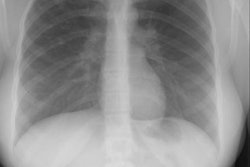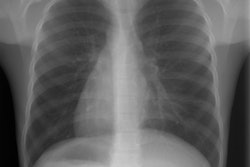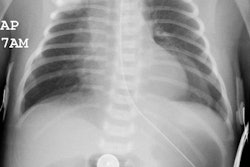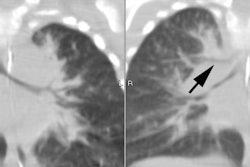Accessory Diaphragm
Clinical:
Accessory diaphragm is also known as a diaphragmatic duplication and is a very rare congenital anomaly [1]. It is not typically an isolated anomaly and it is considered part of the lobar agenesis-aplasia complex [1]. Associations include extralobar pulmonary sequestration, lobar agenesis or aplasia, and unilateral single pulmonary vein [2].
The condition is likely the result of disordered or trapped descent of the septum tranversum [1]. The accessory diaphragm is a fine fibromuscular membrane with a serosal lining that is united to the anterior part of the diaphragm [1] and courses posterosuperiorly to join the posterior chest wall [2]. The postero-superior course produces two compartments in the right hemithorax and part of the lung parenchyma is trapped below the accessory diaphragm [1,2]. The vessels and bronchi that supply the trapped lung pass through a central hole in the accessory hemidiaphragm [1].
X-ray:
An accessory diaphragm can appear in two ways on CXR- 1- when the central hiatus is very narrow the trapped lung is not well aerated and it appears like a mass; 2- when the trapped lung is aerated the right hemidiaphragm has a "hazy" appearance because of the insertion of the accessory diaphragm [1].
On CT, the diaphragm appears like a major fissure with a central hole to which vessels and bronchi converge to enter the lung below [1].
REFERENCES:
(1) AJR 2006; Hildalgo A, et al. 16-MDCT and MR angiography of accessory diaphragm. 187: 149-152
(2) Radiographics 2010; Chavhan GB, et al. Multimodality imaging of the pediatric diaphragm: anatomy and pathologic conditions. 30: 1797-1817



